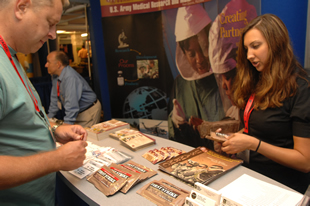Wrapping up the ATACCC conference 2009
The 12th annual Advanced Technology Applications for Combat Casualty Care conference was held Aug. 10-12 at St. Pete's Beach, Fla. The scientific meeting sponsored by the U.S. Army Medical Research and Materiel Command with support from the U.S. Air Force and the U.S. Navy addressed critical advances in trauma medicine and the unique medical needs of the warfighter. Combat casualty care scientists presented their latest findings.
"This year was even better than last year. There is no other forum that provides positive interactions and coordination. We even had a higher number of requests for meeting rooms to network and collaborate outside of our regular meeting rooms," said Col. Dallas Hack, director of the Combat Casualty Care Research Program. "In the presentations, I saw that there is great progress for taking care of our wounded troops."
The purpose of the U.S. Army Medical Research and Materiel Command's Combat Casualty Care Research Program is to reduce the mortality and morbidity resulting from injuries on the battlefield through the development of new life-saving strategies, new surgical techniques, biological and mechanical products.
One of the most challenging medical factors of war has been hemorrhage.
Commander James Hancock presented his lessons learned in "Combat Resuscitative Medicine, Afghanistan."
"When treating combat casualties, minutes count," said Hancock. He discussed how the landscape and culture is different from combat in Iraq.
Capt. John Simmons wrote a paper about a policy change on U.S. Army Combat transfusion practices. He stated military health care personnel do not have a chance to prepare for the battlefield. War trauma is different from wounds in the civilian world.
Simmons said hemorrhages account for 80% of potentially preventable combat casualty deaths.
His paper concluded that shock and coagulopathy, when used alone are poor predictors of the need for massive transfusions.
Also, at the conference were didactic 30 -minute sessions.
Dr. Deb Shear, Dr. Geoffrey Manley, Dr. Larry Glass and Dr. Ronald Hayes discussed their findings in neuroprotection.
Shear and her team tested mice on their sensory motor skills in the Morris Water Maze for five days, running four trials per day. Shear found the Morris Water Maze is best for her experiments.
Manley wrote a paper on the classification of traumatic brain injury.
"It's time for a change. I recommend that we establish a prospective multivariate TBI database. We need to broaden TBI trials and include less "severely" injured patients," said Manley.
Other recommendations included improving CT imaging classification and increasing the use of early MRI.
Manley said all databases need to be consistent so that healthcare professionals can see what's working.
Glass discussed the Intrepid Phase II clinical trial, a drug that potentially can treat acute TBI.
Glass' main concern was whether or not the effects of the drug would be demonstrated during the trials. The drug will be tested in males ages 18-70 that had moderate to severe TBI.
"This would not have happened without the Army," said Glass.
In developing the drug, Walter Reed Army Institute of Research focused on the pharmacology and mechanisms of action while Health Affairs recently awarded $12 million to fund the trials in support of the Defense Centers of Excellence for Psychological Health and Traumatic Brain Injury.
During the Pain Control didactic, there was a presentation based on total intravenous anesthesia techniques in combat casualty care. The disadvantage was the difficulty of measuring anesthetic agent in the plasma. It relies upon a good indicator. However, the benefits are its minimal impact on medics, it withstands environmental extremes, and it is non-flammable.
Hack said he noticed the energy and quality that went into the scientific presentations. "I can see real progress being made. Our medical personnel are striving to find better ways and technology to help the warfighter. It's wonderful."















